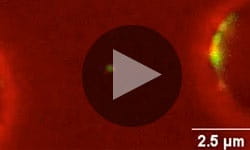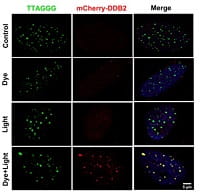
7/22/2019
Surveying 3 billion base pairs, packed into a nucleus just a few microns wide, is a tall order, Van Houten said. Not only is it a lot of material to search through, but it’s wound up so tightly that many molecules can’t access it.
Keeping with the pothole analogy, one possible search strategy is to walk along the road, waiting to step in a hole. Another option is to fly around in a helicopter, but since molecules can’t “see,” this approach would require frequently landing to look for rough patches. To get around these shortcomings, UV-DDB combines both search strategies.
“UV-DDB is like a helicopter that can land and then roll for a couple blocks,” Van Houten said. “It also has the ability to find damage buried in chromosomes and help DNA repair molecules go places they otherwise couldn’t, the way a helicopter can navigate really hilly areas.”
When UV-DDB finds damage, it acts like a foreman to help the DNA repair crew get in, fix the faulty bases and detach quickly.
 For the first time, Van Houten’s team witnessed this molecular tango along a “tightrope” of DNA slung between two silica beads, using real-time, single-molecule imaging.
For the first time, Van Houten’s team witnessed this molecular tango along a “tightrope” of DNA slung between two silica beads, using real-time, single-molecule imaging.
 To show that UV-DDB performs the same functions in living cells, Van Houten recruited the help of Marcel Bruchez, Ph.D., of Carnegie Mellon University, and Patricia Opresko, Ph.D., of Pitt. Together they inflicted oxidative damage to the chromosomes’ protective endcaps—called telomeres. As in the DNA tightrope experiment, UV-DDB rushed to the scene, and when it wasn’t available, cells were more sensitive to oxidative stress.
To show that UV-DDB performs the same functions in living cells, Van Houten recruited the help of Marcel Bruchez, Ph.D., of Carnegie Mellon University, and Patricia Opresko, Ph.D., of Pitt. Together they inflicted oxidative damage to the chromosomes’ protective endcaps—called telomeres. As in the DNA tightrope experiment, UV-DDB rushed to the scene, and when it wasn’t available, cells were more sensitive to oxidative stress.
These results help to explain why children born without functional UV-DDB—a rare disease known as xeroderma pigmentosum—are virtually guaranteed to develop skin cancer from sun exposure, Van Houten said. On the other end of the spectrum, cancer patients with higher levels of UV-DDB respond better to therapy.
“It’s clear this protein is involved in a very fundamental problem,” Van Houten said. “We could not have evolved out of the slime if we didn’t have good DNA repair.”
VIDEO INFO:
CREDIT: Jang et al. (2019) Nature Structural and Molecular Biology
CAPTION: Single-Molecule Imaging of DNA Repair
PHOTO INFO: (click image for larger version)
CREDIT: Jang et al. (2019) Nature Structural and Molecular Biology
CAPTION: UV-DDB Finds Damaged DNA in Living Cells

